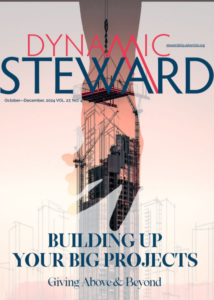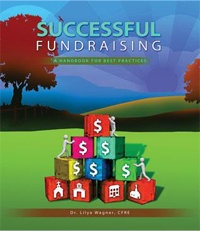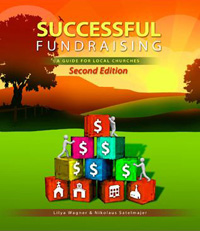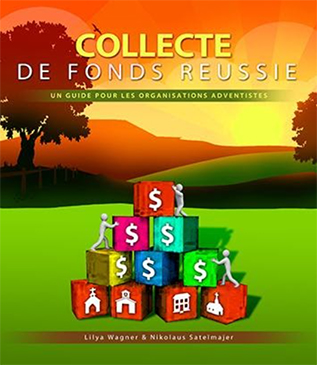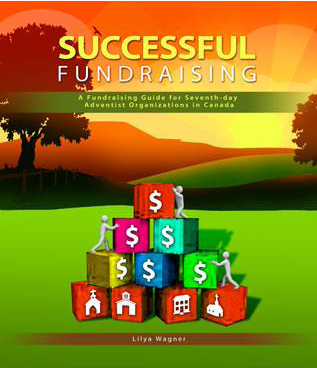News and Notes
PSI is accepting applications for its overhauled MAP 2.0 Program
Now there are both funded and unfunded options available.
A limited number of academies will be considered for both options.
Only complete applications will be processed.
Awardees will be notified via email.
For more details click here
Academies with a Full-Time fundraiser may apply for the funded option by clicking: Funded MAP 2.0 Application
Academies with a Part-time or volunteer fundraiser may apply for the unfunded option by clicking: Unfunded MAP 2.0 Application
Moves Management: Building Personalized Relationships with Your Donors
Moves management is a way to be systematic about cultivating your donors. At it’s heart, it’s simply a fundraising plan, but it’s one that allows you to replicate the same steps for each donor. Follow these steps to implement moves management into your fundraising strategy.
Cultivation & Stewardship, The Dynamic Duo
Only 5% of your time should be spent on soliciting donors.
Another 15% of your time should be devoted to identifying and qualifying.
That means that the other 80% — more than three-quarters of your time — should be dedicated to cultivating and stewarding.
Read more >> from Martha H. Schumacher
The Time is Right for Organizational Learning
Many nonprofits moved swiftly to adjust programming in response to the pandemic, but now they must look within and decide which programs or organizational changes have staying power amid the spread of the Delta variant and talks of returning to the office, write Amanda Stewart, Marlene Walk and Kerry Kuenzi. The authors discuss a process known as organizational learning and how it can help nonprofits assess their operations and move forward while balancing priorities of workers, beneficiaries and equity.
Full Story: Stanford Social Innovation Review
Learn How to Guide Nonprofit Leaders Toward the Truth Instead of Letting Them Rely on Their Opinions
In a role as guide and fundraising coach, your job is to ask the generative (aka leading) questions that direct others to see new possibilities and find their own answers.
Read more >> from Claire Axelrad, J.D., CFRE
Understanding Social Media’s Role in Giving Tuesday and What Your Nonprofit Can Do Today to Prepare
Thanks to social media networks and an emphasis on digital fundraising, Giving Tuesday has been a great driver of online donations for nonprofits.
Read more >> from Nick Wood
Strong donor stewardship a must for nonprofits
Donor stewardship, the process of communicating with and recognizing the contributions of donors, doesn’t end when an individual makes a major gift, writes Gary Grant of the Florida Institute of Technology. Grant discusses the importance of stewardship, along with tips for showing donors recognition and maintaining relationships using traditional and digital methods.
Full Story: The New Social Worker
3 strategies to keep from feeling overwhelmed by work
Many professionals who are feeling overwhelmed should try scheduling moments of respite they can control, such as exercise and socializing, breaks from work and a shutdown routine each evening, writes executive coach Elisabeth Hayes. “Stepping away from your computer for lunch or a short break may not be a panacea for feeling overwhelmed, but it does offer a moment of restoration,” she writes.
Full Story: SmartBrief/Leadership
How curiosity can build trust for leaders
Leaders can build trust by being curious about people, asking what kinds of help they need to be more effective, what their goals are and how they want to be rewarded, writes Steve Keating. “You cannot lead people who do not trust you,” he writes.
Full Story: LeadToday
Why You Should Do A Cost-Benefit Analysis Before Throwing Your Next Nonprofit Fundraising Event
Be thoughtful and honest about what you’ll get out of your nonprofit fundraising event and what you’ll give up to throw it.
Read more >> from Claire Axelrad, J.D., CFRE
[VIDEO] 4-Step Plan to More Donations and Greater Fundraising Results
In this webinar replay, Jesse Lane will share the super-simple process for raising more money for your nonprofit.
Watch now >>
How To Do A Donor Cultivation Event
Even on a shoestring budget you can pull off a donor cultivation event that delights donors and inspires larger and more loyal giving!
Read more >> from Rachel Muir
Be specific and broad to create compelling stories
Good storytelling often starts with specifics before pulling back to reveal a more comprehensive view, all while avoiding “the messy middle,” writes Mimi Johnson. “We’ve found that this simple structure helps weed out unnecessary information that may make your story less impactful,” she writes.Full Story: The Ethos3 Blog
4 steps to renew your focus and passion
A more effective method of recharging and regaining energy starts with not just stopping activity, but also creating time and space to reflect, writes Dan Oestreich. “Reignition isn’t mindless passion; it’s mindful passion,” he writes.
Full Story: Unfolding Leadership
Top Fundraising Strategies: Mastering an Analytical Approach to Strategy and Planning
If you don’t use analytic tools, it’s impossible to know how many people are engaging with your content and what, if any, action they’re taking after that engagement.
Read more >> from Claire Axelrad, J.D., CFRE
A Beginner’s Guide to Throwing a Fundraising Auction: 5 Tips for Item Procurement
Here are five tips for nonprofits looking to throw their first auctions and how you can start planning for one that will wow your guests and inspire them to take action and support your mission:
Read more >> from Madison Gonzalez
How time-blocking can make your schedule easier
Swapping your to-do list for blocks of scheduled time can help you lock in on the most important tasks “without worrying about finding time for deferable tasks,” writes Naphtali Hoff. “In effect, you’re telling yourself, ‘This one task is of great importance to me, and I will devote time and singular focus to it, to the exclusion of everything else,’ ” Hoff writes.
Full Story: SmartBrief/Leadership (8/11)
Why you want team members to criticize you
Specific yet open-ended questions such as “What could I have done better?” can help teammates and reports give you honest feedback — provided you reward constructive criticism, writes “Radical Candor” author Kim Scott. “Remind yourself going in that no matter how unfair the criticism, your first job is to listen with the intent to understand, not to defend yourself,” Scott writes.
Full Story: Radical Candor blog
3 Tips to Create Unforgettable Moments for Donors
What kind of memorable and meaningful experiences are you creating for your donors right now? How can you construct unexpected and unforgettable moments like the Magic Castle does?
Read more >> from Rachel Muir, CFRE
7 ways to effectively praise your team for good work
Make staff recognition meaningful by making it timely, specific, sincere, positive and frequent, says Bob Nelson. “I like to think of ways you can work it into your daily pattern, for instance, at a staff meeting Monday morning, that type of thing,” he says.
Full Story: Chief Executive (7/21)
The Nonprofit Guide to Email Personalization
Email is by far the most popular and effective way for nonprofits to engage supporters. But at scale, emails can lose the things that make them personal, human, and authentic. Download this guide to explore how those traits and techniques can be restored and scaled to help nonprofits grow.
Walker: Philanthropic Band-Aids aren’t cutting it
The voices of women from all walks of life have been ignored for too long, and philanthropy can change that by listening and investing in their communities with a focus on justice, not generosity, says Ford Foundation President Darren Walker. “I think for too long we have focused on Band-Aids — on charity, generosity — which is all admirable and necessary but insufficient to do the transformational work that needs to be done to change culture, to change systems and structures,” says Walker.
Full Story: The Associated Press
BoardSource’s Leading with Intent: Diversity, Equity and Inclusion Findings
As a companion report to our most recent Leading with Intent: BoardSource Index of Nonprofit Board Practices report, we took a look at the findings related to diversity, equity, and inclusion to understand to what extent boards are reflective of the communities they are seeking to serve, how boards are thinking about racial inequity in relation to the organization’s mission and programmatic outcomes, and board practices related to diversity, equity, and inclusion. Read more.
Nonprofit employment improved more than 8% in June
Nonprofit employment increased by more than 8%, or an estimated 60,000 jobs, from May to June and expanded in every segment except health care, according to the Johns Hopkins Center for Civil Society Studies. “While this is a hopeful sign, the volatility in the health care sector — the single largest field of nonprofit employment — makes it difficult to predict when nonprofit jobs will return to their pre-pandemic levels,” said CCSS officials.
Full Story: The NonProfit Times (Morris Plains, N.J.)
Considerations for nonprofit leaders in times of crisis
Nonprofit leaders must be prepared to lead through events that affect single organizations and other crises that affect society at large, such as a pandemic or natural disaster, writes Alex Counts, who is affiliated with the University of Maryland and its Do Good Institute. Counts discusses how leaders can equip their organizations for success during a crisis, including approaching fundraising and partnerships relentlessly — even when times are good.
Full Story: Stanford Social Innovation Review
How to keep your anxiety from affecting the team
When feeling anxious, pause to recognize your emotions, deliberately interrupt your negative thought pattern and change locations, such as with a walk, to clear your head, writes Know Your Team CEO Claire Lew. “We literally must stop and slow down as a leader, if we are to truly lead well when we’re experiencing leadership anxiety,” Lew writes.
Full Story: Know Your Team
5 characteristics of a healthy work environment
It’s a manager’s job to build a work environment where everyone knows the rules, where they fit in the larger picture and understand the many ways feedback should flow, writes Art Petty. Unfortunately, “most environments have no guiding values or expectations to help people navigate the sticky parts, which usually involve people and differences of opinion,” he writes.
Full Story: SmartBrief/Leadership
Beyond Survival: Post-Disruption Nonprofit Digital Strategy
More and more, philanthropic dollars are coming through and across the digital transom. It’s how donors find you, connect with you, and even how many will invest with you.
Read more >> from Claire Axelrad, J.D., CFRE
The 10 Biggest In-Person Ask Blunders
Here’s my list of 10 no-no’s when soliciting gifts from individuals with an in-person ask — or virtually.
Read more >> from Jim Eskin
Why leadership is not one-size-fits-all
Leadership is a series of context-specific skills for succeeding in one-on-one situations, with teams or in broader contexts, writes Susan Fowler. “Lacking awareness of the context you’re leading and not having the skills to lead in it can be dangerous — to you, those you lead and the organization,” she writes.
Full Story: SmartBrief/Leadership
Make room for quiet as you reopen offices
Millions of people who worked remotely during the pandemic have discovered the benefits of a little extra quiet and space to think, and any return-to-offices plan should look to infuse those benefits into how offices function, what meetings are held and how teams communicate, David Dye writes. “What did you stop doing that doesn’t need to come back?” he asks.
Full Story: Let’s Grow Leaders
Say no to office politics — really
Few of us are savvy and agile enough to successfully navigate office politics and gossip, whereas working hard and staying out of the fray can actually earn you more esteem, recognition and situational power, writes Keith Danko, founder of Witherspoon Partners and a former CEO. That said, if you’re at a company “where the office politics start at the very top and are completely infused throughout the business,” you’d best head for the exits.
Full Story: SmartBrief/Leadership
Nonprofit Communications Plan: How to Package Your Message
Having a coherent communications plan where you package your message will help ensure each piece of content you share is part of a greater story you are telling.
Read more >> from Madison Gonzalez
How to Facilitate the Discovery Step of the Donor-Centered Approach
With the right set of donor discovery questions, you will be able to determine the donor’s needs. Your goal is to find out what’s important to them.
Read more >> from Sabrina Walker Hernandez
What do funders look for in grant proposal budgets?
Demonstrating credibility is one of the most important factors in a grant proposal. You may be surprised to learn that the budget in your proposal plays an important role in illustrating your organization’s credibility. Read more
Decisions need a clear decision-maker
Decision-making is more effective when the desired outcomes are clear and it’s known who makes the final decision, write Karin Hurt and David Dye. “You also empower your people to be more influential because when they know who owns the decision, they also know how to share their information,” they write.
Full Story: Let’s Grow Leaders
Why good leaders communicate how much they care
Successful leaders “listen twice as much as they talk” and talk more in terms of “we” and “us” than about themselves, writes Steve Keating. “Authentic Leaders want the people who work with them to believe they can accomplish anything, even one day surpassing the leader,” he writes.
Full Story: LeadToday
How to rekindle your passion when you’re burned out
Whether you’re feeling burned out or just a little singed, some ways to cope include exercise, in-person connections with vaccinated friends, journaling and helping others, writes Scott Eblin. “One of the primary antidotes to burnout is to shift your perspective from the micro annoyances that are right in front of you to the bigger picture perspective and how you fit into it,” he writes.
Full Story: Eblin Group
Being thankful is good to do and keeps employees around
Expressing gratitude for employees’ efforts, whether through personal notes or some other display, helps people feel better about their efforts and can keep them from leaving, says Chester Elton, who shares examples from interviews with leaders. “Gratitude in a business sense is an emotional affirmation that what you did mattered and by extension that you matter,” Elton says.
Full Story: Chief Executive
Who’s Responsible for A Nonprofit’s Culture of Philanthropy?
You must do everything within your power to make philanthropy flow. And it’s not an individual sport. It takes a village.
Read more: from Claire Axelrad, J.D., CFRE
Va. Red Carpet Inn purchased to ease homelessness
A Red Carpet Inn in Charlottesville, Va., found a buyer recently — not a company but rather a coalition of local nonprofits that will use the property to house and otherwise assist homeless people whose plight has been worsened by the pandemic. “The strange silver lining of the COVID era is that it has brought new resources” to the problem of homelessness, says Sunshine Mathon of the Piedmont Housing Alliance, which received a $4.25 million grant for the purchase.
Full Story: Charlottesville Tomorrow (Va.)
Stand for Your Mission Board Member Discussion Guide
It is a fact of life that decisions get made every day that have a profound impact on our missions. Sometimes those decisions are based on ignorance, indifference, or bias. All too often, we are not at the table. So we are forced to pick up the pieces after flawed decisions are made. Our work suffers. Our progress gets delayed. Our missions get compromised. Our missions deserve better. When we are at the table, we can ensure that our priorities are heard, that our communities are represented, that good ideas are funded, and that failing policies are questioned. We can help set the stage for real and lasting success for the people and issues we serve. Read more.
Leveling up your major gifts program
Whether you’re just starting a major gifts program or want to take your current program to the next level, these tips can help your organization get the resources needed to support an equitable pandemic recovery for all. Read more
Creating Story-Worthy Nonprofit Content: Do Something Good to Share Something Good
Sometimes in order to stand out in our messaging and have a story worth sharing, we need to create a story worth sharing.
Read more: from Madison Gonzalez
Consider These Questions Before Reopening the Office
Reopening offices successfully will require ongoing communication, better use of technology and an understanding that culture has changed during the pandemic, writes James daSilva. “Even the fairest process will force some people to change their situation, so also show how you’ll support the transition and how you’ll hold people accountable,” he writes.
Full Story: SmartBrief/Leadership
Nonprofit Content Creation: Back-To-The Basics of the Writing Process
Whenever you are writing your stories, whether it be for a newsletter, for a speech, for an appeal letter, or for a Facebook post, considering going through the following 5 steps:
Read more: from Madison Gonzalez
Tips To Attract & Retain Skilled Volunteers That Grow Your Nonprofit
There are a multitude of factors motivating anyone to become your supporter, and a person’s time and expertise is an incredibly valuable resource and not to be squandered.
Read more: from Nick Wood
Back-To-The-Basic Techniques for Social Media: How-To Use Social Media to Spread Your Mission and Message
Here are a few back-to-the-basics tips and techniques for social media and getting the most out of your presence and efforts.
Read more >> from Madison Gonzalez
4 Strategies to Tweak Major Donor Approaches to Raise More Money
While some donors care about public recognition, they found most respondents care more about solving problems. Specific ones.
Read more >> from Claire Axelrad, J.D., CFRE
How do households make giving decisions?
This report explores charitable giving decision-making in the general population. It analyzes the first new data on this topic for 15 years, and finds that household giving dynamics are changing, with fewer couples making decisions jointly. Indiana University Lilly Family School of Philanthropy Women’s Philanthropy Institute
5 Phases of Strategic Planning
Strategic planning often unfolds in a series of five phases, with each phase building on the one that came before.
When beginning a new phase of strategic planning, it is important to keep a few key questions in mind. This members-only resource includes the five steps to employ while strategic planning, from planning to plan to monitoring your progress. Read more
This is how to create a culture of employee happiness
Employees who feel they’re contributing to the world through their work, have a connection with teammates and know mistakes won’t be held against them are happier and more productive, writes Manick Bhan. “[O]rganizations that make an effort to think about the impact of their brand beyond profits are more primed to keep their employees happy and successful for the long term,” Bhan writes.
Full Story: SmartBrief/Leadership
Want to know how someone feels? Watch their feet
When a person’s feet are pointed toward you or are in a “V” shape, they are likely interested in what you’re saying, but when their feet point away from you, you’ve probably lost them, writes Vanessa Van Edwards. An anxious person will often shuffle their feet, she writes, while crossed feet may signal defensiveness.
Full Story: Science of People (1/6)
Nonprofit Board Orientation Checklist
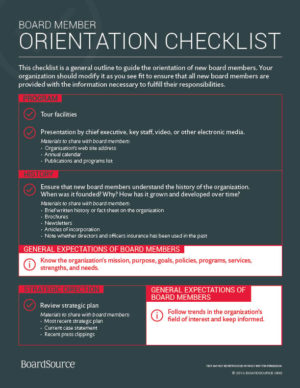 Ensure you are providing new board members with the necessary materials and information during the orientation process. Based on information from The Board Building Cycle and Ten Basic Responsibilities of Nonprofit Boards, this nonprofit board orientation checklist includes important information such as:
Ensure you are providing new board members with the necessary materials and information during the orientation process. Based on information from The Board Building Cycle and Ten Basic Responsibilities of Nonprofit Boards, this nonprofit board orientation checklist includes important information such as:
- materials to share with new board members
- general expectations of board members
- an outline of the information to provide new board members about the organization Read more.
Opinion: Philanthropy indispensable during the pandemic
The philanthropic sector provided essential relief during the pandemic, making a huge difference in the lives of many people in the absence of federal action, writes Patrice Lee Onwuka, a senior policy analyst at Independent Women’s Forum. “As we begin this new year, the pandemic presents a lesson for all Americans: when a crisis strikes, we should not wait for government, but be the first to step up and help each other,” Onwuka writes. Full Story: InsideSources (1/6)
What Do You Do in a Period of Philanthropy Triage?
You likely don’t know your donor’s minds and hearts as well as you did a year ago. It doesn’t mean they won’t still give to you. But you have to make your case anew.
Read more >> from Claire Axelrad, J.D., CFRE
Is Your Nonprofit Board Bored? How-to Keep Board Members Engaged in a Digital Era
– How do we stay motivated and connected and keep board members engaged in a time when we’re all burned out on the computer? Here are three basic, but sometimes overlooked, tips:
Read more >> from Madison Gonzalez
Doing This One Thing Will Help Your Nonprofit Secure Government Funding
While federal grants tend to be complex and are highly competitive, learning how to prepare for and conduct a government funding search can yield positive results and lead to successfully funded projects.
Read more >> from Maddie Zeigler, M.Ed.
When, Who, How (And How Often) to Ask for Monthly Gifts
Having a successful monthly giving program is more than just offering the option to ‘make your gift monthly’ on your donation form.
Read more >> from Rachel Muir, CFRE
2020 proved how adaptable we can be as fundraisers
Women and underrepresented people are quickly becoming the world’s majority, which is why it’s important for nonprofits to adjust their fundraising tactics to reach these segments, writes Kathleen Loehr of Aspen Leadership. Loehr discusses methods for reaching underrepresented donors and points out how rapidly fundraising techniques changed once the pandemic set in.
Full Story: The NonProfit Times (Morris Plains, N.J.) (1/21)
Giving has manifested itself in unique ways this year
Americans have responded to the pandemic with generosity, including moving up their year-end giving and donating in different ways, says Una Osili of the Indiana University Lilly Family School of Philanthropy. Trumpet player Mark Rapp organized online concerts after losing scheduled work opportunities and used the money raised to help other musicians who were out of work.
Full Story: The Wall Street Journal (1/22)
No longer optional: Your digital strategy in 2021
You say you were dragged kicking and screaming into the 21st century? Try these tips to make your peace with technology, because it’s here to stay. Read more
Analyzing Your Past Fundraising Performance
You can’t make a plan about where you’re going to go without examining your performance the past twelve months.
Read more >> from Rachel Muir, CFRE
3 Tips to Hook Your Nonprofit Audience’s Attention from the Beginning
Our minds are curious things and the more you can pique that curiosity quickly, the more likely it is that your audience will want to engage.
Read more >> from Madison Gonzalez
FUNDRAISING ADVICE

FINANCING BIG PROJECTS: Principles for Above-and-Beyond Giving
by Michael J. Brown
When local church leaders embark on raising financial support for building campaigns or other special projects, there can be a delicate balance between mobilizing large-scale resources and avoiding a decline in weekly tithes and offerings. Whether it’s constructing a new sanctuary, establishing a center of influence, or upgrading school facilities, such projects simultaneously inspire excitement and consternation. In situations like that, the key challenge for leadership is to inspire “above-and-beyond giving.” That means fostering increased generosity while maintaining ongoing, annual support. Such reliable financial contributions are mission-critical in covering operating expenses like building and equipment maintenance, salary expenses, or other program and ministry expenses. In this article, we’ll delve into how church leadership can utilize best-in-class philanthropic principles that not only finance big projects effectively but also promote unity, inspire incremental giving, and cultivate a copious culture of generosity.
Keys to Effectively Financing Big Projects
The first question that church leadership should ask themselves requires organizational introspection to answer. Leadership must thoughtfully consider the following: “How ready is our church to ask members to give above and beyond their current level of support?” Congregations tend to be very forgiving if the strategic focus of the local church has been slightly hazy. Congregants are likely to continue to return their tithes and give a level of free-will offerings that adequately support recurring, annual budget needs. However, the situation is totally different when asking for the above-and-beyond giving needed to financially support large-scale special projects or capital campaigns. This is a primary reason that capital campaigns, the behemoth of campaign giving, often stall. The people perish for lack of vision, and in this instance, it is your job to cast that vision contagiously.
When we ask the church body to enter a season of prayer to consider how they might give exponentially more than they have ever given before, and when we ask members to make a moderate- to long-term commitment to sustaining a significantly increased level of giving for a campaign or project, that will most certainly prompt people to begin caring very deeply about and to earnestly yearn for—if not insist on—strategic clarity. They will ask themselves, “Why should I give even more sacrificially than I currently am giving to my church? What is so critically important that I should stretch my faith and increase my level of generosity to a higher financial commitment than I have ever thought of before? Do I really understand what’s going on with this project, and am I as passionate about this project as leadership is?”
The first step in raising above-and-beyond giving is ensuring that members have both clarity about and passion for the core elements of your local church’s strategic plan. Most often, local congregations would benefit immensely from pushing pause so they can craft or refine the church’s strategic focus. That will facilitate every church leader’s and every departmental leader’s ability to sing from the same hymn sheet during a special project or capital campaign. That way the congregation hears a consistent set of messages around which they can rally and proudly be a part of.
The mission—“What are we doing, and what is our mandate?”—must be crystal clear. It will be central in building a case for incremental giving. Doing so helps financial contributors see the role they play in fulfilling the bigger picture, the central purpose their organization fulfills, and the core value they corporately deliver. Clarity in values helps the membership know why we are doing what we’re doing. Research shows that being in alignment from a values standpoint is known to be one of the strongest intrinsic motivators for doing anything, including giving generously. A compelling vision underscores and asks, “Where is God leading us?” It provides supporters with a key milestone along their discipleship journey and indicates how their financial faithfulness is actively helping the church body to get from its current state to its divinely destined future state. With those core components of your ministry’s strategy in place, you are ready to crystalize the most important component in successful fundraising—the case for support.
The fundraising case for support answers three critical questions: Why give? Why give now? And what happens if I don’t give? Although deceptively simple-seeming, crisp answers to these questions empower campaign leadership to convincingly tell the organization’s story about the project under consideration. Making a compelling case for support also gives members a clear idea of what a God-inspired, cooperative future together looks like. It raises the relevance of giving because people do not give to organizations; they give to causes. And people give most generously to transformational causes. The bigger the ask, the larger the transformational impact supporters expect to see, experience, feel, and hear about. Never forget that the purpose of fundraising campaigns is to operationalize the social impact of your strategic plan. It isn’t about securing equipment or buildings; it is ultimately about transforming lives. That is what generous givers desire to hear about, the key point you need to consistently communicate: transformed lives. For example, financing a new STEM lab means creating a stimulating environment for students to discover the mysteries of Creation. Replacing a leaking roof means creating a safe, inviting environment wherein community members can come to learn God’s design for their spiritual, physical, and financial lives. Successful fundraising, especially for big projects, is not about how to manipulate people into making charitable donations. It is about growing authentic relationships wherein potential supporters are motivated to give generously to transform lives.
For Christian ministries, it is essential to take things a step further. Christian fundraising must simultaneously yield financial and spiritual fruit. This reminds me of a call I received from a conference treasurer who was aware that a member had recently inherited a large sum of money. Basically, the question posed to me was how best to structure the ask. The questions I posed in response were: What is the spiritual benefit for the prospective donor? How will they grow spiritually through the process? How does making this gift tie into that member’s philanthropic interests? There was a pregnant pause wherein we both realized that the donor exchange was heading toward a transactional focus instead of a relational focus. Fortunately, the treasurer pushed pause long enough to consider the spiritual aspects of both asking and giving. When giving is primarily seen as a transaction, with relationships on the back burner, generosity is thwarted and trust is diminished.
Trust-Based Philanthropy
Generous giving is rooted in trusting relationships, and trust is a pivotal key to unlocking congregational generosity. Although the capacity to give is an essential precursor to a propensity to give, that inclination to give is significantly moderated by trust. Above-and-beyond giving is dependent upon a high degree of trust. Building trust influences a donor’s willingness to give by assuring donors that their contributions are well-managed. Another contingent for trust is assuring donors that their donations are used efficiently and effectively for their intended purpose(s). This transparency in reporting can be done in many ways, some more compelling than others. For instance, adhering to the best practice of acknowledging gifts within 48 hours of having received them provides an opportunity to give the donor a timely receipt for their gift. It also offers a fertile period during which you can illustrate the impact of the gift and go a step further to acknowledge the donor and their role in helping move the mission forward. Something that few churches do, but many other nonprofits routinely do, is the creation of a ministry impact report.
Due to cost and convenience, ministry impact reports are usually produced in digital format. They are a great way to highlight accomplished goals, spotlight ministry impact, overview community service projects, and collectively honor ministry supporters. Through impact reports, you can affirm donors’ decisions to financially support the ministry and plant the seeds to consider increasing their level of engagement and support. You can find several examples by typing “ministry impact report” into your favorite search engine. There you will find local Christian church examples like the Reformed Church in America. You will also find creative examples of integrating ministry impact reports into campaigns like the Wycliffe Bible Translators. Through integrated marketing communications like these, you will build donor trust that convincingly shows the ministry value of every dollar raised and stimulate the trust needed to increase above-and-beyond giving, a central role in and reflection of a vibrant culture of generosity.
Cultivating a Culture of Generosity
A broad, long-term solution for increasing above-and-beyond giving is to consistently cultivate a culture of generosity. Doing so requires intentionality in developing a long-term focus on creating a fertile environment wherein generosity naturally and abundantly flourishes. This requires taking intentional, strategic steps to establish an environment that ignites Spirit-led, whole-life stewardship. It is stewardship that mobilizes multigenerational philanthropy to collectively serve communities and reflect the transforming love of Christ in and through membership. It is characterized by unbridled joy in giving (2 Corinthians 9:6, 7) and reaps the fruit of the spiritual gift of giving (Romans 12:8). It teaches the 7 T’s of Stewardship: Time, Temple, Talent, Treasure, Trust, Theology, and Testimony. It also shows the membership how to expand ministry through principles and practices of successful fundraising. And it encourages establishing a legacy of incremental giving by making a planned gift. It is an environment wherein giving inspires spiritual growth.
You will find that people’s faith in God grows exponentially with their generous giving. Married couples will have purposeful conversations about their lives, purpose, and resources. Members begin to experience God, enabling them to commit more financial resources than previously imagined. People gain greater financial freedom because they have increased financial resources available for giving. People grow their commitment to Christ and share a vision of attaining true life (1 Timothy 6:17–19). A culture of generosity culminates in the church body growing its faith in God and intensifying its commitment to the local congregation. That is the long view of funding big projects with above-and-beyond giving.
DONOR RETENTION REVISITED: Fundraising Effectiveness Project Update
By Eddie Thompson

In February 2016 I posted an article entitled PLUGGING THE LEAKS: The True Impact of a 1% Increase in Your Donor Retention Rate. Since that was almost six years ago, I thought it high time to revisit the data. Many of you are well aware the news is not good on any of the donor-retention measurements. So, I’ll not belabor the point but briefly summarize some of the realities of the current nonprofit world. Then I’ll try to offer some perspective and constructive advice.
If you are all too aware of the bad news, you can fast-forward to MY PERSPECTIVE and STRATEGIC SUGGESTIONS below.
QUICK REVIEW
In 2006 the Association of Fundraising Professionals (AFP) launched the Fundraising Effectiveness Project (FEP) to conduct research each year on fundraising effectiveness—the source of my previous blog post. The AFP-FEP 2016 annual report was based on responses from 9,922 U.S. nonprofits that raised a combined total of $8.625 billion in the previous year (2015).
THE UPDATED STATS
The Fundraising Effectiveness Project (FEP) has continued to monitor donor-retention rates each quarter since the initial FEP survey—the source of this article. The ongoing quarterly surveys show the following as the “average retention rates” across all surveyed nonprofits.
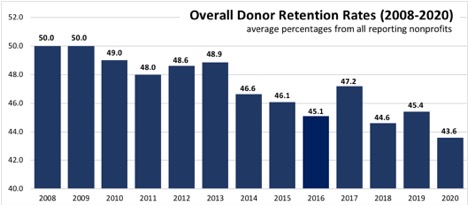
Source: Fundraising Effectiveness Project
1. The Overall Donor Retention Rate is the number of donors who gave in the previous year and gave again in the following year, divided by the total number of donors in the previous year. Only 46.1% of the donors who contributed at least once in 2014, contributed again in 2015. That reflects a 15-year trend—a slow but steady decline from a 50% retention rate in 2008. In the years since my 2016 article on donor retention, the overall donor retention rate has fallen to 43.6% in 2020. The inverse (a 56% donor-attrition rate) means that well over half the existing donors (first-time and repeat donors) did not give in the following year.
2. The Retention Rate for New (First-time) Donors in 2016 was 25.3% and, like the overall donor retention rates, has steadily declined to 19.3% in 2020. In other words, over 80% of the first-time donors the surveyed nonprofits attracted to their organizations in 2020 did not give in the second year, and the vast majority never gave again.
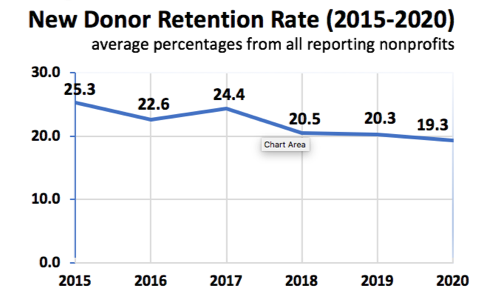
Source: Fundraising Effectiveness Project
Dr. Adrian Sargeant is the Robert P. Hartsook Professor of Fundraising at the Lilly Family School of Philanthropy at Indiana University. He wrote in the Nonprofit Quarterly, “It typically costs nonprofits two to three times more to recruit a new donor than that donor will give in their first donation. It can take twelve to eighteen months before a donor relationship becomes profitable.”1
3. The Year-Over-Year (YoY) Recapture Rate is the percentage of donors who did not give in a succeeding year but gave again in the third year. In other words, they lapsed for a year but were “recaptured” as donors the following year. Trying to put a positive spin on a lost donor, some will say, “But we are confident they will give again.” Unfortunately, once they’re gone, they rarely come back. Among the 9,000+ reporting organizations in the 2016 FEP survey, only 5.8% of lapsed donors gave again in the succeeding year. That rate continued to decline to 3.9% then rebounded slightly to 4.4% in 2020.
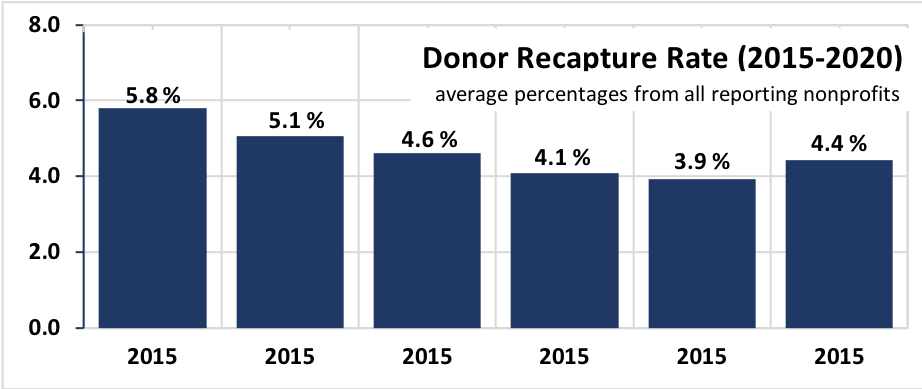
Source: Fundraising Effectiveness Project
MY PERSPECTIVE
A comprehensive fund development program has a lot of moving parts, and it’s not easy to give all those parts the attention they need. Nonprofits can focus on program performance, unrestricted gifts, public relations, recruiting board members, or servicing a dozen other squeaky wheels. The year-over-year decline in donor retention rates is so small that you hardly notice the squeaking. However, donor retention has been on a steady decline for the last 15 years. It often goes without attention or concern when evaluating the immediate past or future. When looking at the big picture of organizational sustainability, it’s like a fire alarm going off in your organizational house.
I would like to say that all nonprofits are acutely aware of these trends. However, I’m not so sure they are. Since 2005, there’s been a hyper-emphasis on new-donor acquisition. Increasingly, new-donor acquisitions are what performance metrics measure and reward—rarely the more significant impact of donor retention. How few times have you heard of promotions or outstanding performance reviews that were based primarily on a fundraiser’s ability to keep current donors enthusiastic and engaged?
Short-sighted leadership decisions can also compound the problem. As strange as it may sound, many organizations are dealing with the impact of low donor-retention rates by either reducing development staff or redoubling their efforts on new-donor acquisitions. There seems to be a correlation between the declining donor-retention rate and declining development staff-per-major-donor.
An unfortunate trend among nonprofits is that donor relationships have become increasingly non-personal—organizational communications are pushed out in the form of emails, blogs, social media posts, as well as highly sophisticated direct-mail appeals. While these forms of donor-communication updates may be expected and necessary in the electronic world of mass media, lots of studies show they are a grossly ineffective means of donor relations and donor retention. In July 2020 I posted an article on the OVER-RELIANCE ON ELECTRONIC COMMUNICATIONS. A few stats from that post:
- For every 1,000 broadcast emails delivered, nonprofits raised $45 (i.e. less than 5 cents per delivered email). 2018 M+R Benchmarks Report:
- Nonprofits raised $0.83 per website visitor in 2018. Overall, 1% of website visitors made a donation. 2018 M+R Benchmarks Report:
- 5% of overall fundraising in 2018 came from online giving (i.e. 91.5% came from other sources)—Blackbaud Charitable Giving Report.
Personal communications via Zoom as a temporary alternative is one thing; reliance on social media or broadcast emails for donor relations is a different thing altogether.
MY STRATEGIC SUGGESTIONS
Okay, enough of the bad news. Below are a few things you might consider:
SUGGESTION #1: Cultivate Habitual Givers. If a donor agreed to make a $2,500 gift, I might suggest setting up a $200 per month automatic recurring donation (totaling $2,400). I’m not concerned about the $100 the organization might lose over the next 12 months. I’m much more interested in the donor-retention trends.
The overall donor-retention rate in 2020 was 43%; the retention rate for repeat donors from the previous year was 60%, and the retention rate for new donors was a measly 19%. However, a 2017 benchmark study from the Association of Fundraising Professionals found that monthly recurring donors were retained at a rate that hovered around an astounding 90%. So, you’d think that nonprofits would do whatever they could to create a culture of habitual giving. That same study reported equally astounding statistics—that only 14% of nonprofits prompt one-time online donors to upgrade to a recurring giver during the donation process (i.e. 86% don’t even ask).
Click here for Fundraising Advice archives
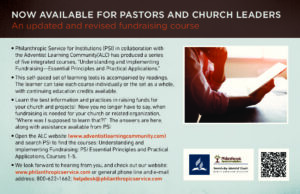
NOW AVAILABLE FOR PASTORS AND CHURCH LEADERS
An updated and revised fundraising course
▪ Philanthropic Service for Institutions (PSI) in collaboration with the Adventist Learning Community(ALC) has produced a series of five integrated courses, “Understanding and Implementing Fundraising—Essential Principles and Practical Applications.”
▪ This self-paced set of learning tools is accompanied by readings. The learner can take each course individually or the set as a whole, with continuing education credits available.
▪ Learn the best information and practices in raising funds for your Church and projects! Now you no longer have to say, when fundraising is needed for your Church or related organization, “Where was I supposed to learn that?!” The answers are here, along with assistance available from PSI
▪ Open the ALC website (www.adventistlearningcommunity.com) and search PSI to find the courses: Understanding and Implementing Fundraising: PSI Essential Principles and Practical Applications, Courses 1-5.
▪ Contact PSI by e-mail at randyfox@nadadventist.org
ALUMNI GUIDE
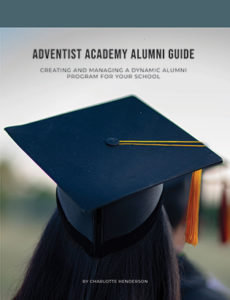
“Where do I begin?” is the question most often asked when a new alumni or development director is hired at a Seventh-day Adventist academy. This handbook, created by Charlotte Henderson, answers that question by taking you through the steps to building and maintaining a successful alumni program.
Topics include:
- Budgets
- Alumni database and communications
- Volunteers
- Recognition
- Alumni weekend and special events
- Creating an alumni constitution
- Responsibilities of board members
- And More.
Please look up this special issue at AdventSource.
Books and Resources
Successful Fundraising
Are you planning a building project—a new church, addition, school building, or Community Service building? Do you wonder how you should go about getting the funds? Does it seem like your campaign for funds goes on forever? Are your members or constituents tired of talking about money? If you have these questions and probably many others, Successful Fundraising is for you. Explore the options below to see which edition is right for you.

